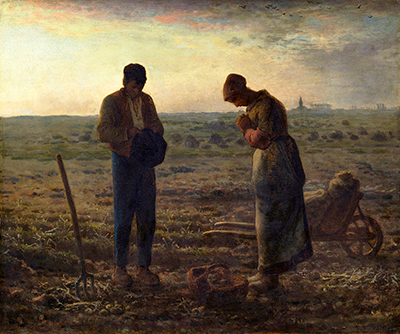This intriguing oil-on-canvas painting, "The Angelus", hangs in the Musée d'Orsay, in Paris. The rural artist, Jean-François Millet (1814-1875), painted it between 1857 and 1859.
"The Angelus" is a painting centred on rural spiritual devotion. It is a rather dark and shadowy painting showing two peasant figures in a sprawling field at dusk, full of atmosphere and mood. It grabs the viewer's attention and curiosity.
The two central figures, a man and a woman, are praying. A little information may help the viewer to better appreciate the scene. The Angelus is a prayer. Every Sunday, the Pope appears at his window and recites the Angelus to an enormous crowd gathered in Saint Peter's Square. Millet's twilight "Angelus" is a much more intimate and down-to-earth affair. In the painting, the church bell is ringing out the end-of-day Angelus, and the two peasants have stopped gathering potatoes to pray together.
This simple rural ritual is a childhood memory: Millet recalls how his grandmother stopped all work in the fields on hearing the church bell. It was the moment of the Angelus prayer. Rustic scenes, labouring peasants and rural life feature heavily in Millet's artistic production; "The Angelus" shows us a brief moment of respite and devotion at the end of the working day.
The painting is small, 55.5 x 66 cm, yet it conveys enormous space around and behind the two figures. We can almost see the entire Plain of Chailly, the location of the potato fields. The hour is late, the picture is inevitably dark, yet in the deepening dusk we can still make out the basket, the pitchfork, the wheelbarrow, and we can just see the village and the church spire in the background. The style is Realism and the two peasants are shown clearly and realistically in tired and dusty prayer; they stand out in silhouette against a slowly darkening sky. We feel their exhaustion and their devotion, we sense the coolness of the evening and we can hear the church bell ringing.
There is a charming anecdote about the ringing bell. The painting had changed hands many times and in 1860 it was part of the Van Praet collection. Van Praet, the Belgian minister, exchanged it for another Millet painting and was hard put to explain the reason for the swap. He ironically offered the following explanation: “It is a masterpiece. Observing the two peasants who have stopped work to pray, everyone thinks they can hear the nearby church bell tolling out the Angelus. In the end, the constant ringing became rather tiresome”.




